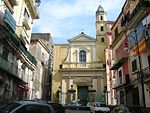Stabiae

Stabiae (Latin: [ˈstabɪ.ae̯]) was an ancient city situated near the modern town of Castellammare di Stabia and approximately 4.5 km southwest of Pompeii. Like Pompeii, and being only 16 km (9.9 mi) from Mount Vesuvius, this seaside resort was largely buried by tephra ash in 79 AD eruption of Mount Vesuvius, in this case at a smaller depth of up to five metres.Stabiae is most famous for the Roman villas found near the ancient city which are regarded as some of the most stunning architectural and artistic remains from any Roman villas. They are the largest concentration of excellently preserved, enormous, elite seaside villas found from the entire Roman world. The villas were sited on a 50 m high headland overlooking the Gulf of Naples. Although it was discovered before Pompeii in 1749, unlike Pompeii and Herculaneum, Stabiae was reburied by 1782 and so failed to establish itself as a destination for travellers on the Grand Tour. Many of the objects and frescoes taken from these villas are now in the National Archaeological Museum of Naples.
Excerpt from the Wikipedia article Stabiae (License: CC BY-SA 3.0, Authors, Images).Stabiae
Piazzale Tibullo,
Geographical coordinates (GPS) Address Nearby Places Show on map
Geographical coordinates (GPS)
| Latitude | Longitude |
|---|---|
| N 40.703055555556 ° | E 14.498888888889 ° |
Address
Scavi archeologici di Stabia
Piazzale Tibullo
80053
Campania, Italy
Open on Google Maps








